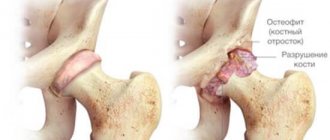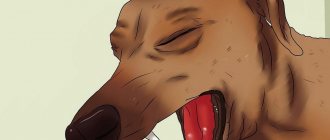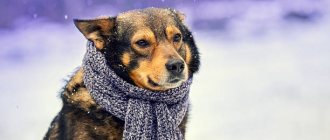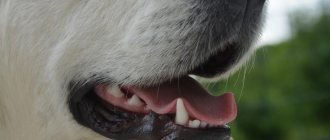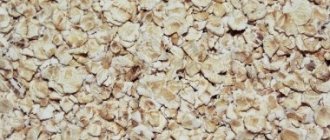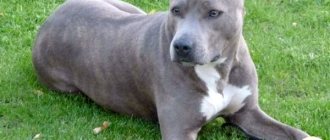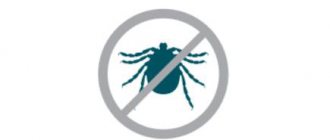Seasonal influenza epidemics are a serious problem in human society, affecting a significant portion of the population every year. Rarely does our winter go by without exceeding the epidemic threshold for influenza and acute respiratory infections. A similar situation exists among our smaller brothers. Dogs also suffer from viral infections and have epidemics. One of the most common upper respiratory tract infections is called parainfluenza. From this article you will learn what parainfluenza is in dogs, routes of infection, main symptoms, as well as methods of treatment and prevention.
Causes of development and causative agent of the disease
Parainfluenza is a viral infection. Its pathogens belong to the paramyxovirus family. Five varieties of parainfluenza pathogens have been studied. In dogs, the disease is caused by the CPIV-2 strain. It was discovered by American scientists in the 60s of the last century.
The virus enters the animal’s body and is localized in regional lymph nodes. It is also found in the epithelial structures that line the larynx, bronchi, and nasal cavity. The causative agent of parainfluenza is unstable in the external environment. It dies at room temperature within a few hours. A temperature of 55 degrees is considered fatal for the virus.
Routes of transmission and infection
Like any virus, the causative agent of parainfluenza is transmitted to a dog by airborne droplets. There is a high probability of becoming infected in dogs that live in kennels, attend exhibitions, and interact with other dogs on walks.
Find out about the advantages and disadvantages of Wolf's Blood food for dogs, as well as the daily feeding rate for your pet.
A photo of a Brazilian terrier, characteristics of the breed and features of keeping a pet can be seen in this article.
Most susceptible to the disease:
- puppies up to 1 year;
- pregnant and lactating bitches;
- weakened animals (due to operations, chronic pathologies, helminthic infestations).
Provoking factors
Parainfluenza develops intensively in those dogs whose immune systems are weakened. Various factors can lead to this condition:
- stressful situations;
- improper feeding, poor, unbalanced food;
- lack of regular walks and sufficient physical activity;
- worms and skin parasites;
- keeping in dampness, cold;
- lack of vaccination.
Risk of infection for humans
The parainfluenza strain CPIV-2 affects only dogs. Therefore, a person cannot become infected from his pet. Although a person in contact with a sick animal can bring the virus home on clothes and shoes. But this probability is very low, because parainfluenza pathogens are very unstable in the external environment.
Pathogen information
Parainfluenza is caused by a virus from the paramyxovirus family. The peculiarity of these viruses is their resistance. There are 5 types of parainfluenza pathogens. Their activity is not determined by the season, but in the cold season, outbreaks occur more often due to decreased immunity in animals.
Animals with reduced immunity, puppies, elderly individuals, and dogs suffering from chronic diseases are susceptible to the disease. This virus primarily affects the mucous membrane of the nose, nasopharynx and larynx.
The canine parainfluenza virus (CPIV-2) was discovered by American zoologists back in the sixties of the twentieth century. The infection caused by this virus was highly contagious. It affected the mucous membranes of the upper respiratory tract and manifested itself as a sharp, hysterical cough, which is why it received the name: kennel cough.
Signs and symptoms
Penetrating into the body, the infectious agent attaches to the mucous membranes and begins to actively multiply and infect the lymph nodes. As a result, the dog's condition deteriorates sharply. Before external signs of parainfluenza appear, there is an incubation period, the duration of which can vary from several days to a month. Although the animal feels fine, it is already a carrier of infection. The symptoms of the disease itself are very vague and can easily be attributed to a number of other infections.
At the initial stage, the dog may experience characteristic symptoms:
- a rough, dry cough that gets worse with physical activity (kennel cough);
- loss of appetite;
- gradually increasing weakness;
- tearfulness;
- photophobia;
- slight increase in temperature.
At the stage of acute progression of the disease, the clinical picture becomes more pronounced, which is associated with the penetration of the virus into the blood and lymph.
The dog appears:
- heat;
- loss of appetite;
- strong thirst;
- purulent discharge from the eyes;
- dyspnea;
- wheezing in the bronchi;
- in the intestinal form – vomiting and profuse diarrhea;
- possible development of pneumonia.
If the immune system works normally, it begins to produce antibodies against the virus. The amount of it in the blood decreases, and the dog begins to recover.
Prevention of parainfluenza
If you want your purebred pet to appear at various exhibitions in the future, it must be vaccinated. Every owner of a four-legged friend should be interested in the possibility of vaccination. Don't wait for illness. Your dog should be vaccinated immediately to avoid future infection.
The vaccination process, dose and route of administration depend on the age of the dog. Puppies should be vaccinated at five or six weeks after birth. Subsequent doses are given every three to four weeks. Thereafter, a parainfluenza vaccine is recommended every 24 months.
Vaccination is not required for animals that have short contact with other dogs, as they have a very low risk of disease. The procedure is recommended for four-legged dogs that regularly come into contact with a large number of other dogs.
As for comprehensive protection against influenza, the same rules apply as for other diseases.
- It is very important to maintain hygiene and take care of your dog's diet.
- You need to beware of colds.
- Make sure your dog is completely dry before going outside.
- Never leave your animal in the cold or rain for long periods of time.
It is especially important during parainfluenza to remain calm and not succumb to negative emotions and stress. Parainfluenza can be cured, but nerve cells, as you know, are not restored!
Currently reading:
- Thyroid dysfunction in dogs (hypothyroidism)
- The American Cocker Spaniel is an adroit hunter and loyal friend.
- Tips for proper dog burial
- Seven Signs and Remedies for Getting Rid of Fleas in Dogs
Diagnostics
Considering that the symptoms of parainfluenza overlap with other diseases, it is imperative to carry out a differential diagnosis.
An accurate diagnosis can only be made based on a number of studies:
- physical examination with analysis of respiratory auscultation;
- chest x-ray;
- Ultrasound of internal organs;
- throat swabs to identify the type of pathogen;
- special test systems;
- determination of the level of immunoglobulins M and G in the blood.
It is necessary to exclude other pathologies with similar symptoms:
- adenovirus;
- plague;
- rotavirus and coronavirus infections;
- herpes;
- pneumonia;
- heart failure.
Important! Before treating your dog, you should consult a doctor and do not take any steps on your own so as not to aggravate the situation. It is necessary to assess how severe the disease is and whether there are any associated complications.
Treatment Options
Unfortunately, there are no special means aimed at combating parainfluenza. Therefore, treatment can only be symptomatic.
As a rule, the doctor prescribes several groups of drugs:
- immunomodulators;
- vitamins;
- antibiotics and other drugs.
General rules
To speed up recovery from viral infections, it is necessary, first of all, to provide proper care to the sick dog:
- isolate from other animals;
- eliminate stress;
- give complete rest;
- place in a warm, well-ventilated area without drafts;
- give as much to drink as possible;
- feed warm food, give vitamin and mineral supplements.
Antibiotics
Although parainfluenza is a viral infection, it is often accompanied by complications in the form of bacterial microflora.
Doctors prescribe a course of broad-spectrum antibiotics:
- Doxycycline;
- Monocycline.
The dosage is selected based on the dog's weight. On average, a course of antibiotic therapy lasts 5-10 days.
To minimize the side effects of antibiotics, the dog is given hepatoprotectors (Karsil, Gepabene) in parallel. To maintain normal intestinal microflora, probiotics (Vetom, Laktobifid) and enzymes (Prozym, Cohamix) are used.
Immunomodulators and vitamins
The main fighter against the virus during parainfluenza is immunity. Therefore, it needs to be strengthened and stimulated.
During treatment, they resort to the help of vitamins:
- 5A-37;
- Gamma;
- Beaphar Doggy's Biotin;
- Canina V25 Vitamin tabletten.
The homeopathic drug Engystol is widely used for viral infections in dogs. It is administered intravenously. It activates the body's immune forces and enhances the elimination of toxins. The drug has antiviral, immunomodulatory, sympatholytic effects.
In some cases, faster recovery can be achieved through the use of immunomodulators:
- Gamavit;
- Fosprenil;
- Immunofan.
Folk remedies
In addition to the main treatment, decoctions and infusions of herbs are used to help a weakened body:
- St. John's wort;
- chamomile;
- calendula;
- rose hip;
- Rhodiola rosea.
They can be used individually or in a mixture. Pour 2 teaspoons of raw material into a glass of boiling water. Leave for about 1 hour, strain. Give 10-15 drops three times a day, warm. You can add the decoction to drinking water.
Before using herbal remedies, you must make sure that your dog is not allergic to them.
How often can you wash your dog and what products are recommended to use for water procedures? We have the answer!
The first signs, symptoms and effective methods of treating gingivitis in small breed dogs are written on this page.
Go to the address and read about how and what to make a dog collar with your own hands at home.
Treatment of the disease
In the absence of secondary infections, parainfluenza in most cases is suggested to be treated with symptomatic means, since there are no veterinary antiviral drugs for this purpose. Well-chosen symptomatic treatment has a beneficial effect on the animal’s immune system, and this helps it cope with the infection in a short time. The main complexes of drugs for the treatment of parainfluenza are as follows:
- codeine-based antitussives;
- vitamin therapy;
- immunomodulators (Engystol);
- maintenance therapy based on homeopathy;
- good care, which consists of providing complete rest, good nutrition and the absence of stress.
If the slightest signs of secondary infections are detected and to prevent the process from becoming chronic, antibiotics from the cyclosporine group can be prescribed. For persistent cough, bronchi dilators (Salbutamol) are used in combination with corticosteroids.
Consequences and complications
If parainfluenza is not complicated by secondary infections, the animal usually recovers within 7-8 days. But this doesn't always happen. If the immune system cannot cope with the virus, then its activity can cause unpleasant consequences.
The intestinal form of the disease is very dangerous. The dog develops profuse diarrhea. She cannot control her bowel movements. This can subsequently cause severe dehydration and even death of the animal.
The parainfluenza virus in combination with a bacterial infection complicates the condition. Bronchitis, laryngotracheitis, and pneumonia develop. In dogs of large breeds, diseases of the cardiovascular system are often observed against the background of a viral infection.
A prolonged disease is dangerous due to degeneration into a virus carrier. Externally, the dog may appear healthy. But she remains a carrier of the virus, which means she is potentially dangerous to other dogs.
Mechanism of disease development
The parainfluenza virus can enter the body of a weakened dog during direct contact or through airborne droplets. It attaches to mucous membranes and multiplies in the body, affecting the lymph nodes. The animal's condition is rapidly deteriorating. The incubation period can last from one or two days to several weeks. The mortality rate of animals from parainfluenza is low, but in small puppies, after the pathogen enters the bloodstream, serious complications can develop.
The parainfluenza virus is the causative agent of serious pathology of the upper respiratory tract. It is called infectious tracheobronchitis or kennel cough in dogs. The virus often acts in combination with a bacterial infection (the causative agent is Bordetella bronchiseptica), which complicates the course of the disease. In this case, the incubation period becomes shorter and ranges from one day to a week. The disease itself can last up to three weeks. After recovery, the dog remains a carrier of the infection for some time, infecting its fellow dogs.
The name of the disease - kennel or kennel cough - indicates that it is widespread where a large number of dogs are kept at the same time - in dog shelters, kennels, dog playgrounds or exhibitions. Protection against it lies in timely vaccination of the dog. There is a polyvalent (containing several types of antibodies) vaccine, the use of which helps create reliable immune protection when dogs are kept in groups.
This virus is species-specific, that is, it is adapted to life and development exclusively in the body of a dog and is not transmitted to people.
Provoking factors
The provoking factors of the disease are circumstances leading to a deterioration of immunity. This is especially important when keeping animals in groups. It is known from experience that if one dog in a kennel gets a viral infection, it will be very difficult to protect the rest. Such defects in keeping animals as:
- frequent stress, too harsh upbringing;
- low-quality food, diet poor in nutrients;
- vitamin deficiency, lack of microelements;
- physical inactivity and lack of fresh air;
- poor health, a large number of chronic diseases;
- helminths and the presence of skin parasites;
- keeping in street conditions;
- lack of necessary vaccinations.


